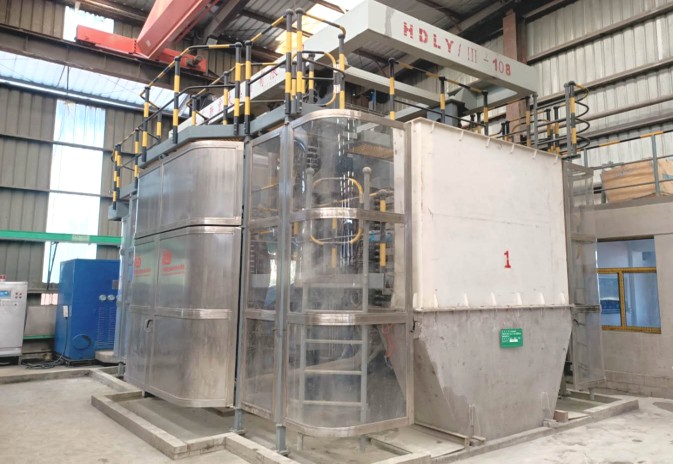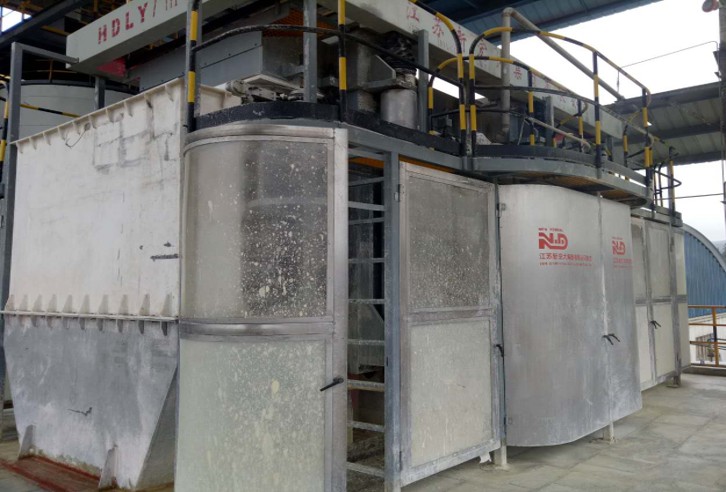The selection of a suitable filter press for wastewater treatment depends on treatment capacity because it determines operational efficiency and regulatory compliance and cost-effectiveness in industrial and municipal facilities. The wastewater treatment process depends on filter presses to perform solid-liquid separation which enables sludge volume reduction and water quality enhancement. The selection process for filter presses based on treatment capacity requires evaluation of their operational functions and design elements and operational requirements and system limitations.

Role of Filter Press in Wastewater Treatment Processes
Filter presses are vital for solid-liquid separation in industries like environmental protection, chemical production, and metallurgy.
Basic Functions of a Filter Press
The filter press functions through slurry pumping into spaces between filter plates. The increasing pressure forces liquid to pass through the filter cloth while solid particles build up into a cake. The process works well for removing water from sludge in wastewater treatment facilities.
Key Components and Operational Mechanism
A standard filter press consists of filter plates together with a hydraulic system for plate compression and feed pumps and filter cloths. The filter cloth performs dual functions by filtering while also transporting materials so its strength and stability play a crucial role in design requirements. The process starts by adding slurry to the chamber (Step 1) followed by cake formation (Step 2) and then washing (Step 3) and air drying (Step 4) before the final cake discharge (Step 5). The system operates at its peak pressure of 16 kg while the air drying process achieves extremely low moisture content in the filter cake.
Importance in Solid-Liquid Separation
The separation process of filter presses operates with maximum efficiency through minimal chemical substance usage. The equipment finds its best application in situations where sludge contains high solid concentrations and needs additional drying before disposal or additional processing steps.
Factors Influencing Filter Press Capacity Selection
The selection of appropriate capacity requires knowledge about wastewater properties and operational requirements.
Volume and Nature of Wastewater
The size of the system depends on both the amount of water that enters each day and how much it changes from day to day. Plants that handle large volumes need either bigger equipment or multiple units to stop production delays.
Sludge Characteristics and Solids Loading Rate
The formation of thick cakes from sludge with high solid content happens quickly but needs powerful equipment to handle it. The suspended particles in this water are extremely small and do not settle on their own and certain materials need flocculants to settle. The knowledge of particle size distribution enables proper calculation of required filtration surface area.
Desired Cycle Time and Dewatering Efficiency
Shorter cycle times lead to higher processing rates but they can decrease the dryness levels. The process of dewatering becomes more effective with longer cycles although this leads to reduced production rates per hour. The system needs to achieve equilibrium between these two factors to maintain stable operation.
Types of Filter Presses and Their Impact on Capacity
Your selection between manual or automatic systems and chamber or membrane designs will determine the capacity planning requirements.
Manual vs. Automatic Filter Press Systems
The level of automation determines how much labor is required and how consistent the production cycle remains.
Operational Differences and Labor Considerations
The operation of manual presses depends on human operators to move plates and extract cakes. Modern systems operate automatically and continuously which results in less downtime and reduced work for operators.
Suitability for Different Plant Sizes
Small facilities with restricted financial resources tend to use manual systems for their operations. Large-scale operations achieve better results through automated systems because these systems provide both scalability and enhanced operational efficiency.
Chamber vs. Membrane Filter Presses
Design variations determine how a system operates when facing different operational environments.
Performance Comparison in Varying Conditions
The operation of Chamber presses depends only on feed pressure to create cakes. Membrane presses use mechanical pressure to squeeze materials for enhanced dryness levels. The high-pressure water system in the high-pressure pipeto enables liquid discharge through its operation. Membrane types work best for applications that need low moisture content and for handling sticky materials.
Design Parameters Affecting Capacity Planning
The process of determining required capacity requires evaluation of multiple technical specifications.
Plate Size and Number of Plates
The use of bigger plates enables higher cake volumes during each cycle but they need more space and need to be supported by robust frames. The addition of more plates leads to higher filtration surface area but it makes maintenance operations more complicated.
Filtration Area and Cake Thickness
The filtration area of the equipment determines the amount of slurry that can be processed during one cycle. The thickness of the cake determines how much solid material it holds but it also causes longer processing times because of its slow drainage rate. The maximum filtration area of the current equipment setup reaches 168㎡.
Feed Pressure and Flow Rate
Higher feed pressures lead to faster cake formation but they also increase the stress on equipment components. The selection of proper pumps allows for optimal flow rates which protects equipment from damage while maintaining safety standards.
Operational Considerations for Capacity Optimization
The actual operational environment plays a more significant role than design specifications when it comes to achieving long-term production efficiency.
Cycle Time Management and Downtime Reduction
The production time can be reduced by minimizing non-productive activities that include cake discharge and cloth washing. The unloading process takes between 30 to 40 seconds to complete.
Maintenance Frequency and Component Durability
The resistance of polymer membranes to wear comes from their durable nature which protects them against abrasive sludges and corrosive chemicals. Acid and alkali resistantSimple to make and low cost. The implementation of scheduled maintenance protocols helps prevent unexpected shutdowns which would disrupt treatment process operations.
Integration with Pre-treatment and Post-treatment Systems
The alignment of filter presses with upstream thickening stages and downstream drying stages leads to better operational efficiency. The water content reduction process happens in thickeners before pressing operations while dryers handle the remaining moisture after pressing.
Common Challenges in Capacity Selection for Wastewater Applications
Engineers at all levels encounter challenges when sizing equipment because wastewater environments present unpredictable operating conditions.
Overestimating or Underestimating Processing Needs
The use of oversized equipment results in underutilized resources while undersized equipment leads to storage accumulation during high-demand periods. The process of pilot testing enables organizations to replicate actual operational scenarios before launching their complete system.
Dealing with Variable Influent Characteristics
Sludge composition becomes unpredictable when seasonal changes or industrial waste releases occur. The ability of flexible systems to modify pressure and cycle duration makes them more suitable for long-term operation.
Balancing Cost, Space, and Performance Requirements
The limited availability of floor space and high utility costs create challenges for system design when working within budget restrictions. The four-column vertical structure maintains a compact design which requires only 15m*6m of floor space.
NHD: A Reliable Supplier for Comprehensive Filtration Solutions
The NHD product line includes various filtration solutions which serve different industrial requirements including environmental protection and sulfuric acid production and pharmaceuticals and coal chemicals applications.
Overview of NHD’s Product Offerings
The market now offers numerous product categories which include vacuum filter and filter press and agitator and thickener among hundreds of different models.
Filter Series & Automatic Press Filter Series
The automatic vertical filter presses from NHD operate at high pressure levels of 16 kg/cm² to produce dry cakes which are suitable for phosphogypsum dewatering operations that require low moisture content.
Agitator & Thickener Series, Desulfurization Equipment Series
The pre-treatment units enhance system performance through slurry conditioning which leads to better filtration results in subsequent stages.
Equipment for Sulfuric Acid Industry, Pressure Vessel Series
The gas scrubbing system operates as a specialized solution that enables gas-liquid separation operations in addition to standard solid-liquid separation duties at Fertilizer facilities. The implementation of BlueFil technology at Fertilizer facilities has brought about significant improvements to operational processes and product quality.
Filter Cloth Series, Material Series
NHD produces specialized panos for sludge filtration which deliver peak performance across all sludge types including both coarse particulate and ultra-fine suspension materials. The adjustable pore structure of the cloth enables it to match the filtration requirements of various slurry types.

Conclusion
The selection of an appropriate filter press for treatment capacity depends on analyzing wastewater characteristics and operational requirements and system design elements and integration requirements and supplier expertise in complex systems. NHD has operated for decades through thousands of worldwide projects and has completed more than 800 projects in environmental protection and advanced filtration technology solutions.
FAQs:
Q1: How is the correct filter press size selected?
A: Selecting the correct filter press size involves evaluating daily sludge volume and solid content percentage. The filtration area calculation must account for desired cycle times and downtime between cycles to prevent bottlenecks and ensure continuous operation.
Q2: What is the most suitable filter press for treating highly corrosive wastewater?
A: The polymer membrane filter press is ideal for treating acid-based effluent in metal finishing and chemical plant operations, offering acid/alkali resistance and high filtration precision down to 5-micron particles.
Q3: Can a single filter press maintain operational stability when sludge properties change?
A: Yes, modern automatic membrane presses feature adjustable pressure controls and programmable cycle functions, enabling flexible operation to handle seasonal or upstream changes in sludge properties for consistent year-round performance.


